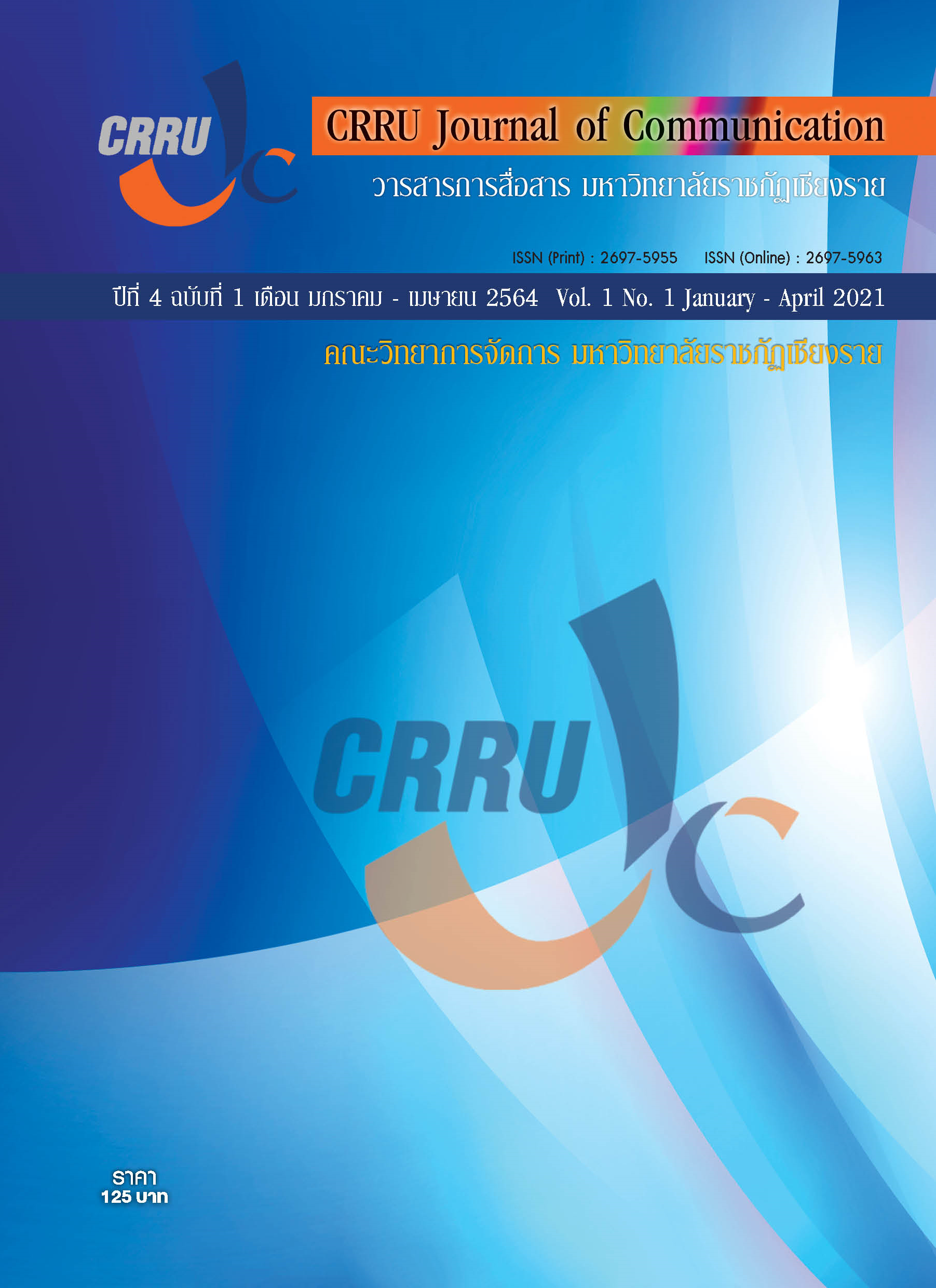Advertising Hai Law Taw Kup Cheang: The creativity, awareness and the response of TVC on campaign to anti-drink alcohol
Main Article Content
Abstract
The qualitative methology was designed to study for Hai Law Taw Kup Cheang: The creativity, awareness and the response of TVC on campaign to anti-drink alcohol. The research objective to study the perceptions and the responses of drinkers in Thailand towards the advertising films "Giving alcohol = curse". The in-depth interviews with 10 key contributors were arranged. The research finding could be summarized that the opinions on the creation of the advertising campaign "Giving alcohol = curse” over the past 10 years could be classified into 2 phases; at the beginning of the project between 2008 to 2013, most people had the supportive opinion to this campaign as a good project that related to the trendy intention in healthy concern. It gave the audiences a rational knowledge and the congruent understanding of drinking behavior at that moment. During the second phase between 2014 to 2019, most people have the opposing opinions because the advertising message were inconsistent to their current drinking behavior. Moreover, the drinkers had decoded the funny and fear motivation in this advertising campaign as an insult to their being. Finally, they seem to suggest the liguor enterprises should get involved If this campaign was needed to continue.
Article Details
References
กันยา สุวรรณแสง. (2532).จิตวิทยาทั่วไป: General psychology. พิมพ์ครั้งที่ 5. กรุงเทพฯ : บำรุงสาส์น.
ฉัตรยาพร เสมอใจ. (2550). พฤติกรรมผู้บริโภค.กรุงเทพฯ : ซีเอ็ดยูเคชั่น.
ฐิติพร แก้ววิมล. (2559). การสื่อสารเพื่อการรณรงค์ในโครงการ “อย่าให้ใครว่าไทย”. สารนิพนธ์วารสารศาสตรมหาบัณฑิต สาขาบริหารสื่อสารมวลชน มหาวิทยาลัยธรรมศาสตร์
ชัยวัฒน์ สถาอานันท์. (2553). ความรุนแรงซ่อน/หาสังคมไทย. กรุงเทพฯ :สำนักพิมพ์มติชน.
ธงชัย สันติวงษ์. (2540). พฤติกรรมผู้บริโภค. พิมพ์ครั้งที่ 9. กรุงเทพฯ: บริษัทโรงพิมพ์ไทยวัฒนาพานิชจํากัด.
ธีรพล ภูรัต. ( 2558). การสร้างสรรค์งานโฆษณา. ปทุมธานี : มหาวิทยาลัยกรุงเทพ.
นิธิ เอียวศรีวงศ์. (2561). นิธิ เอียวศรีวงศ์ : ให้เหล้า ≠ แช่ง. สืบค้นเมื่อ 30 พฤศจิกายน 2560. จาก https://www.matichonweekly.com/column/article_76303
วรรณพิมล อังคศิริสรรพ. (2547). มายาคติของ Roland Barthes.กรุงเทพฯ : โครงการจัดพิมพ์คบไฟ
ศรีรัฐ ภักดีรณชิตและคณะ. (2560). การวิเคราะห์เนื้อหาสื่อโฆษณารณรงค์ต่อต้านการสูบบุหรี่ใน โทรทัศน์ไทย. วารสารวิชาการนวัตกรรมสื่อสารสังคม. 5(2(10)) : 102-113.
สุดารัตน์ แสงแก้ว และคณะ. (2561). คุณลักษณะและความชัดเจนของผู้มีอิทธิพลทางการตลาด:กลุ่มผู้นำทางความคิด. จุฬาลงกรณ์ธุรกิจปริทัศน์. 40 (157). กรกฎาคม-กันยายน: 1-24.
สุวิชนี พันธุ์เพ็ง.(2558). การเปรียบเทียบผลการเลือกเปิดรับภาพในการรณรงค์ผ่านสื่อสังคมออนไลน์ที่ใช้แรงจูงใจแบบความกลัวและแบบเอื้ออาทรต่อการให้การช่วยเหลือสุนัขที่ประสบทุกข์.สารนิพนธ์ศิลปศาสตรมหาบัณฑิต สาขานิเทศศาสตร์และนวัตกรรม สถาบันบัณฑิตพัฒนบริหารศาสตร์
สุพัฒนุช สอนดำริห์. (1 กุมภาพันธ์ 2563). เจาะความสำเร็จ เบื้องลึกหนังโฆษณา สสส. เมื่อ 6 เมษายน 2563 จาก https://www.bangkokbiznews.com/recommended/detail/1939
สำนักงานประชาสัมพันธ์.(2553).กระเช้าปีใหม่ “ให้เหล้า เท่ากับแช่ง” สืบค้นเมื่อ 24 พฤศจิกายน 2562 จากhttps://hq.prd.go.th/prTechnicalDM/ewt_news.php?nid=557&filename=index
สำนักงานกองทุนสนับสนุนการสร้างเสริมสุขภาพ. (19 ธันวาคม 2556 ). ให้เหล้าเท่ากับแช่ง. สืบค้นเมื่อ 24 พฤศจิกายน 2562 จาก https://www.thaihealth.or.th/
เสาวณีย์ ฉัตรแก้ว. (2551). การรณรงค์ประชาสัมพันธ์สร้างจิตสำนึกสาธารณะของประชาชนผ่านองค์กรภาครัญ องค์กรธุรกิจเอกชน และองค์กรไม่แสวงหากำไร. กรุงเทพฯ : มหาวิทยาลัยธุรกิจบัณฑิตย์
มาณี ไชยธีรานุวัฒศิริ (2006) .พฤติกรรมการบริโภคเครื่องดื่มแอลกอฮอล์ของคนไทย.รามาธิบดีพยาบาลสาร. 18(2). 259-271.
สุรเดช ตั้งเติมเจริญ. (2556) ประสิทธิผลของสื่อโฆษณาทางโทรทัศน์เพื่อการรณผิดพลาด! ไม่พบแหล่งการอ้างอิงรงค์เมาไม่ขับ ชุด “โทรหาแอ๊ด”มีผลต่อการเปลี่ยนแปลงพฤติกรรมของผู้บริโภคเครื่องดื่มแอลกอฮอล์. การค้นคว้าอิสระนี้เป็นส่วนหนึ่งของการศึกษาตามหลักสูตรนิเทศศาสตรมหาบัณฑิต มหาวิทยาลัยกรุงเทพ.
Predrag Jovanović and et al. (2016). Impact of Advertising Appeals on Purchase Intention. Management Journal of Sustainable Business and Management Solutions in Emerging Economies 21(81):35-45
Belch, George E. & Michael A. Belch. (1990). Introduction to Advertising and Promotion Management. Boston : Von Hoffmann Press.
Belch, G. E., & Belch, M. A.(1995) . Introduction to advertising and promotion: an integrated marketing communication perspection (3nd ed.). Chicago, IL: Irwin.
Jonathan Bignell. (1997). Media Semiotics: An Introduction. UK : Manchester University Press.
Haley, R. I., & Baldinger, A. I. (1991). The ARF copy research validity project. Journal of Advertising Research, 31(3), 11-32.
Hawkins, D.I., Roger, J.B., and Kenneth, A.C.(1998). Consumer Behavior: Building Marketing Strategy. 7th ed.. Boston: McGraw Hill.
Hoyer, W. D., & Maclnnis, D. J. (2000). Consumer behavior (2nd ed.). Boston, MA: Houghton Mifflin.
Rice, R. E., & Paisley, W. J. (1981). Public Communication campaigns. Newbury Park,CA: Sage.
Rogers, Everette M. (1979). Communication Campaign. New York : The Free Press.
Ronald E. Rice and Willian J. Paisley (1989).Public Communication Campaign. Beverlt Hills : Sage.
Schermerhorn, J. R., Hunt, J. G., and Osborn, R. N. (1982). Managing Organizational Behavior. New York : John Wiley and Sons Inc.
Social marketing of Thaihealth. ให้เหล้าเท่ากับแช่ง แอลกอฮอล์. สืบค้นจาก https://www.socialmarketing.
thaihealth.or.th/index.php?option=com_campaign&view=contentlist&cat_id=23
Nyilasy G. and Canniford R. (2012). Ad agency professionals’ mental model of advertising creativity. European Journal of Markerting. 47(10). 1691-1710.
Ad agency professionals’ mental models of advertising creativity
Rice, R. E., & Paisley, W. J. (1981). Public Communication campaigns. Newbury Park,CA: Sage.
David Rocaa and et al. (2017). Creativity identity in Colombia: the advertising creatives’perspective. International Journal Of Advertsing.
DOI: 10.1080/02650487.2017.1374318 To link to this article: http://dx.doi.org/10.1080/02650487.2017.1374318


